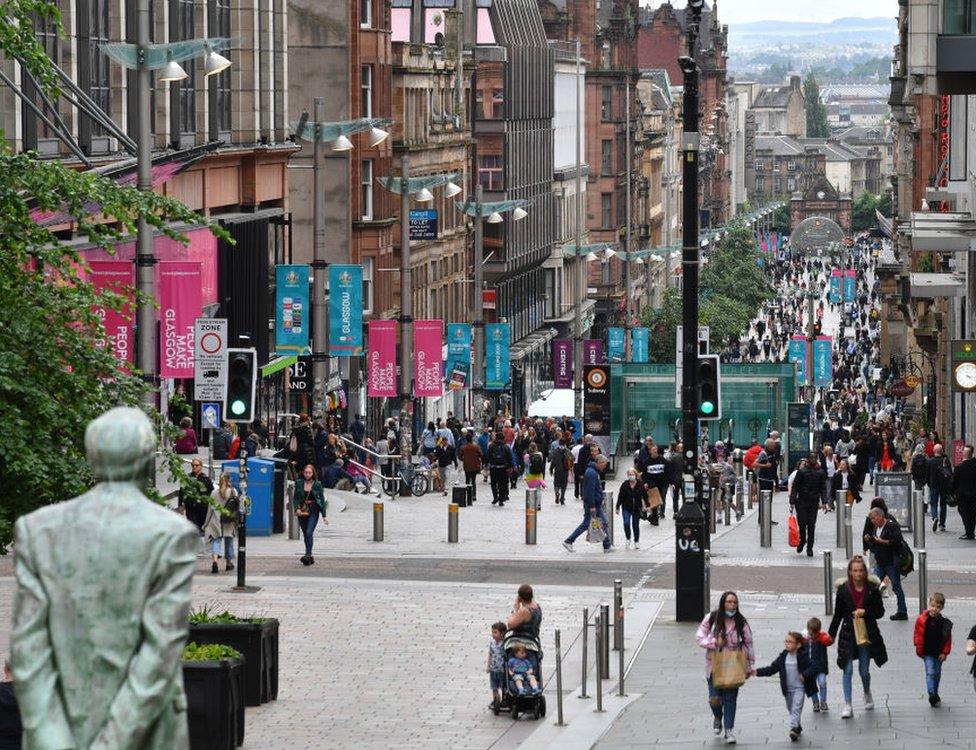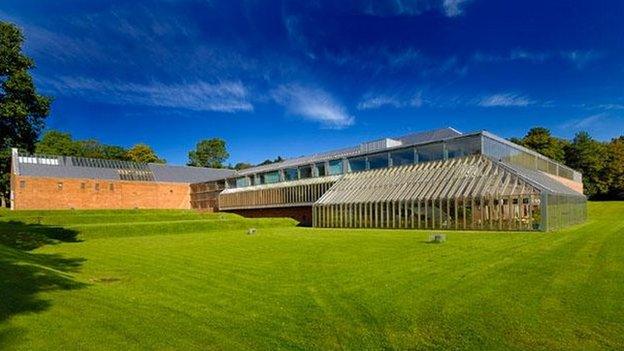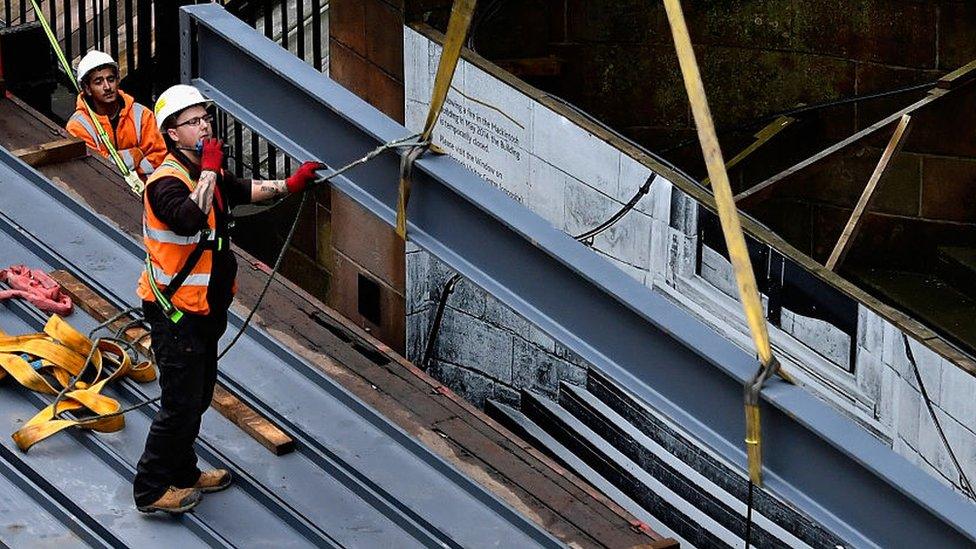£30bn greenprint for Glasgow
- Published

Scotland's biggest city has the world's focus on it for the climate change summit, so it's making the case for some big inward investment with which it can set an example.
Some projects are already under way, but a small eco-forest of feasibility studies is in preparation for much more spending: from tree planting to recycled clothing to drawing heat from the Clyde, up to the big ticket items of a metro system and vast retrofit of poorly insulated homes.
Apart from the £30bn price tag and impressing foreign investors, the Glasgow "greenprint" brings challenges of building a green supply chain that benefits the city and Scotland. The construction industry says that requires a change in government mindset about value for money.
Being ambitious can pay off. So when the world's attention is focused on Glasgow, why not shoot for the moon?
Thus, today, we get a £30bn prospectus for the city. It is a bundled-up portfolio of public works aimed at big-scale investors and at what urban planners like to call "place-making" - buildings, spaces and travel corridors that work for the people who use them.
This comes less than 50 days before the Cop26 summit descends on the city in the hope of a Glasgow Agreement, with which to save the world from multiple climate-related catastrophes.
The city - so named from the Gaelic for "place of the green hollow" and known from books to comedy as "the dear green place" - seems to be taking the lower road, with a pre-summit sterrheid rammy about the state of its litter and rubbish collections.
But the city council hopes to aim higher than the problem of discarded Buckfast bottles. The prospect of council elections next May may not be coincidental.
Some of the work programme is already well under way. The plan for Mission Clyde was set out a year and two days ago. Much of it looks like old-fashioned development of brownfield sites stretching well past the city boundaries, but daubed with a lot of green.
There's a pioneering district heating plan for Clydebank, for instance. The next plan is to use waste to heat homes near the vast and privately-run Polmadie waste handling centre, stretching across the M74 to the Gorbals.
Useful learning
Much of the vision is around two of the city's universities. Strathclyde was at the heart of the country's first innovation district stretching far beyond its campus boundaries, now with added "climate neutral" status. As in Clydebank, it aims to source its heat from harnessing the River Clyde, just as others aim to draw power from the air and the ground.
With Glasgow University building a large new campus on the site of the former Western General Hospital, it's seeking innovative ways to deliver education and research with lower climate impact.
The research from both institutions is a big part of the appeal Glasgow is setting out to be a place of useful learning (Strathclyde's motto).
This extends south of the river and into Renfrewshire, to the Advanced Manufacturing Innovation District. There are contracts already in place with Boeing and others to design new ways to lighten the load for aircraft, the same reason that Spirit Aerosystems, the US aerospace giant with a large footprint in Prestwick, opened its new research centre this week.
Metropolis
The private sector is an even bigger part of Clyde Gateway plans in the east of the city, to regenerate it with higher quality housing and green space, with £1.5bn of the big plan already delivered.
Being a long way from the Subway that followed a Victorian loop around industrial Glasgow, the east end and seven other council areas would benefit from a plan for a metro.
This is one of the items in the plan with a big price ticket on it.
How big? Before publishing a feasibility study and lobbying the Scottish government to include it in its strategic transport plans this autumn, all the prospectus tells us is "multi-billions". And the City Growth Deal can only stretch to around £142m of that, it is claimed.
Innovative heating
Innovative heating systems are, again, a big part of the ambition for the next waves of building new homes, as "a pilot site for fifth generation energy systems which focus on low temperature closed loop systems with heat pump technology linked to individual buildings".
The green space around that housing is to be part of one part of the plan that seems particularly ambitious in a compact city. Glasgow has generous parkland, but the goal of planting 18 million new trees might make you wonder where that's possible.

There are plans to provide higher quality housing in the city
Some way off is the arrival of Micro Park UK, which is another plan still at the feasibility project stage. With the imprint of Strathclyde University, it is trying to tap into the calculation that 10 to 15% of Britain's clothing needs could be brought back from distant manufacturing while cutting the carbon footprint of making them.
The idea is to have 20 manufacturing units at the hub, using renewable energy sources and sharing technology for low-energy cleaning and production, together employing up to 4,000 people. Training would be onsite.
Retrofitcity
That has a price tag of £120m. But it is with retrofitting the existing housing stock that the big numbers arrive. Some £10bn is given as the price tag of upgrading the insulation and energy efficiency of 428,000 homes that currently fail to make the net zero grade.
I was looking recently at just one classic sandstone tenement block on the southside, and the scale of what is required - not least the decanting occupants into other homes for long periods of time - seemed truly daunting.
Again, this is at the stage of a feasibility study, but the claim is that it could generate 75,000 jobs and £4.4bn of value for the city economy over 10 years, removing more than 10 million tonnes of carbon emissions from the atmosphere each year.
The possibilities are there for local companies, including Scottish manufacturers, to scale up their operations to meet the coming demand for retrofitting materials and skills.
But the launch of the plan comes only a day after a leading figure in the construction industry told the MSPs' economy and fair work committee that the same old way of contracting for public construction works, by competitive bidding that drives down prices to unsustainable levels, is no way to deliver the transformation the industry and the country need.
Economy Minister Ivan McKee has sought to respond to the shortage of supplies of materials to construction this year by finding Scottish manufacturers who can take up the challenge of fulfilling the demand.
Andrew Richards, a member of the construction industry leadership council, told MSPs that the complexity of the materials, and the need to test them rigorously, means there is very little that can be done short term.
And long term, is there the forward thinking in the private and public sector to fill that gap - recognising that the Scottish construction and retrofitting market is not big enough to build manufacturing at the necessary scale?
It's not yet apparent, but we can live in hope that the rhetoric of economic transformation could yet become reality.
Kennedy Greenway
Also by coincidence, the launch of this prospectus and "greenprint" coincides with a Westminster committee report pointing out how much institutional foreign investment is drawn into London and south-east England.
After those, Scotland has a track record of doing well with foreign direct investment. But it'll have to up its game if this £30bn plan is to be realised.
All this talk of investment and transformation of Glasgow into a greener place - and a dear one at that - is in search of symbol of a city truly transformed.
Those who recall 1982 and the opening of the Burrell Collection in Pollok Park will recall how it symbolised the rejuvenation of the city as a cultural centre.

The Burrell Collection in Pollok Park will recall how it symbolised the rejuvenation of the city as a cultural centre
The project that could do that for this Glasgow "greenprint" is to put its sacred turf over the M8 at Charing Cross. And it is possible within five years.
The giant scar where motor traffic cut through the heart of the city centre in the later 1960s could be covered over in a new park, reconnecting the commercial district and rail stations with the west end, and with the magnificent Mitchell Library at its heart.
Such a "Big Dig" sunk an interstate highway through the heart of Boston, at humongous cost. The cover over the road created the Rose Fitzgerald Greenway of parks and walkways, linking the Massachusetts city centre once more with its historic shorefront, docklands and tea party venue.
Talking of quaysides, regular readers of this blog will understand my disappointment that there is nothing in this plan that would put a river bus service (tide-powered and battery-operated) on the Clyde. We must have faith. That dream shall never sink.
- Published23 September 2021

- Published6 August 2021
- Published21 September 2020